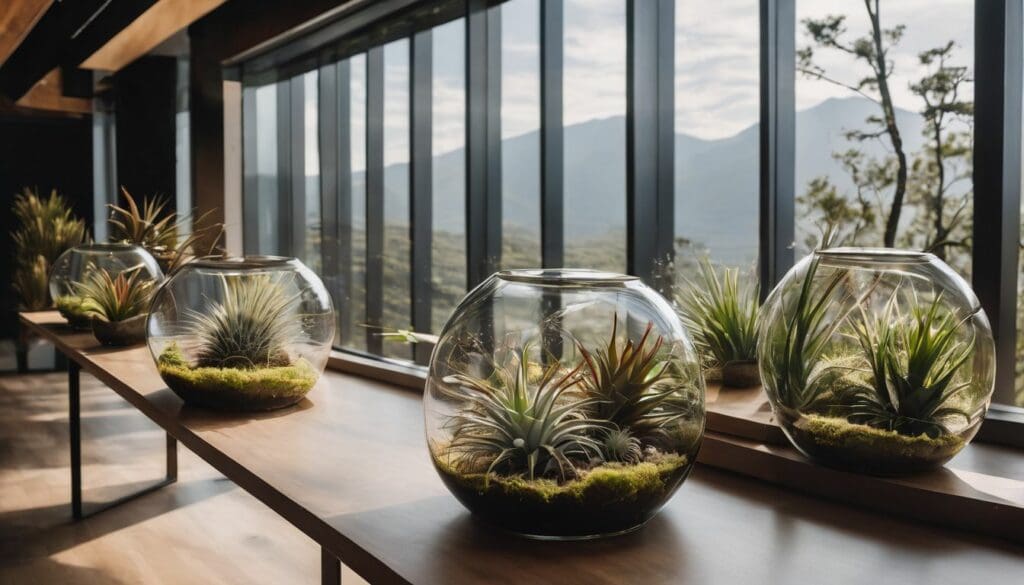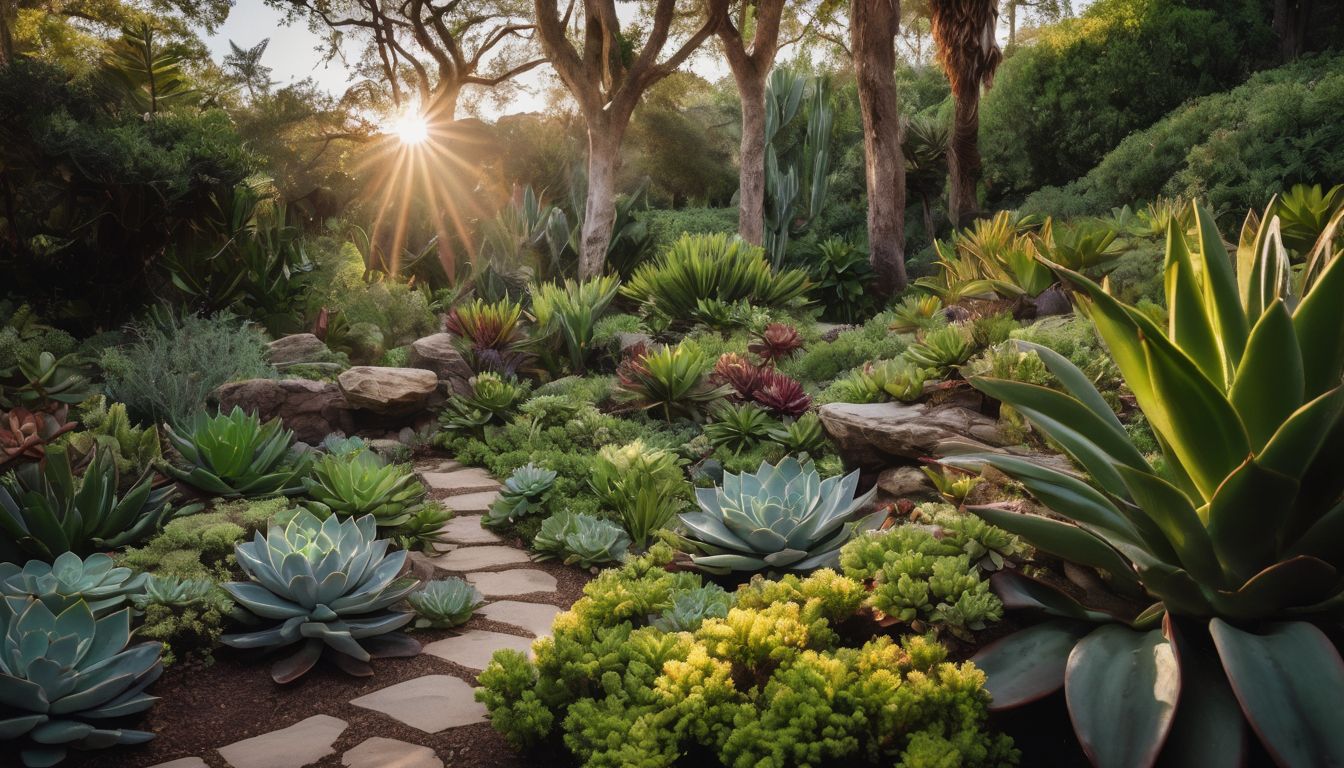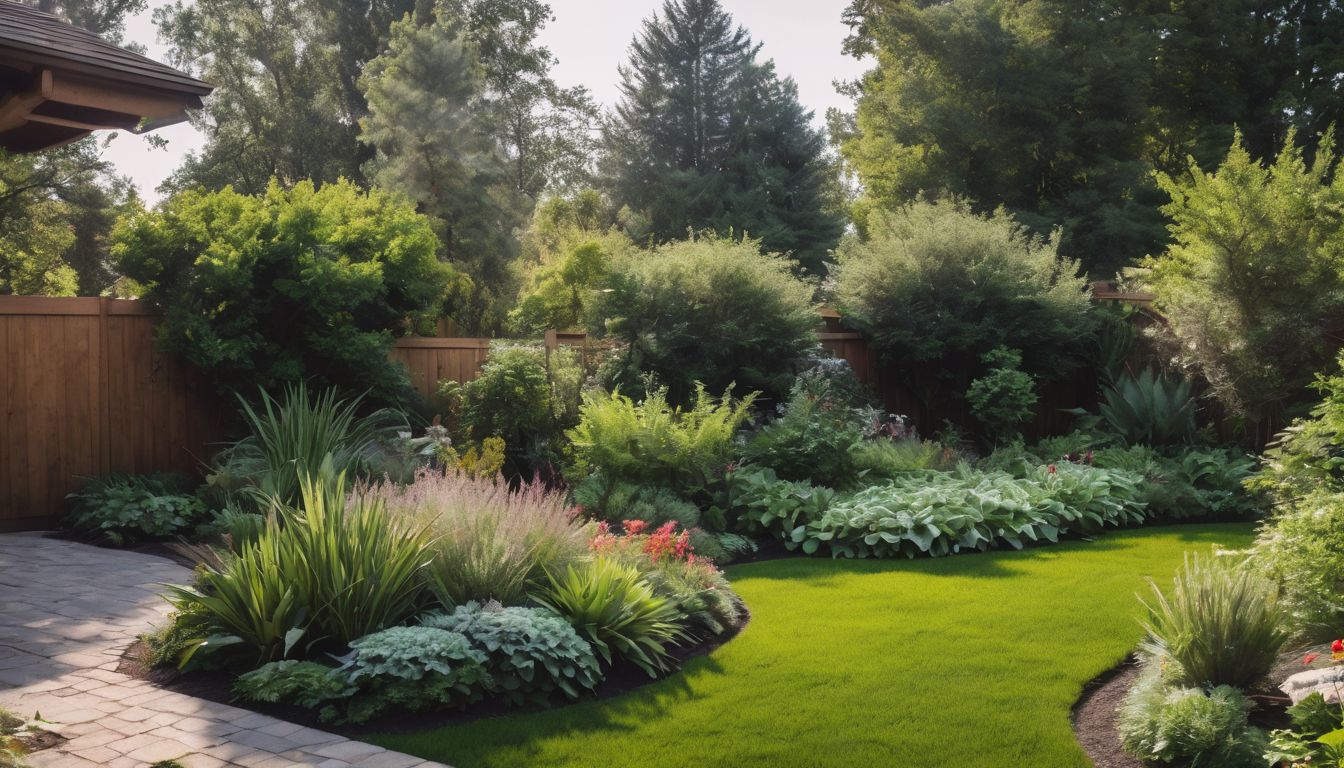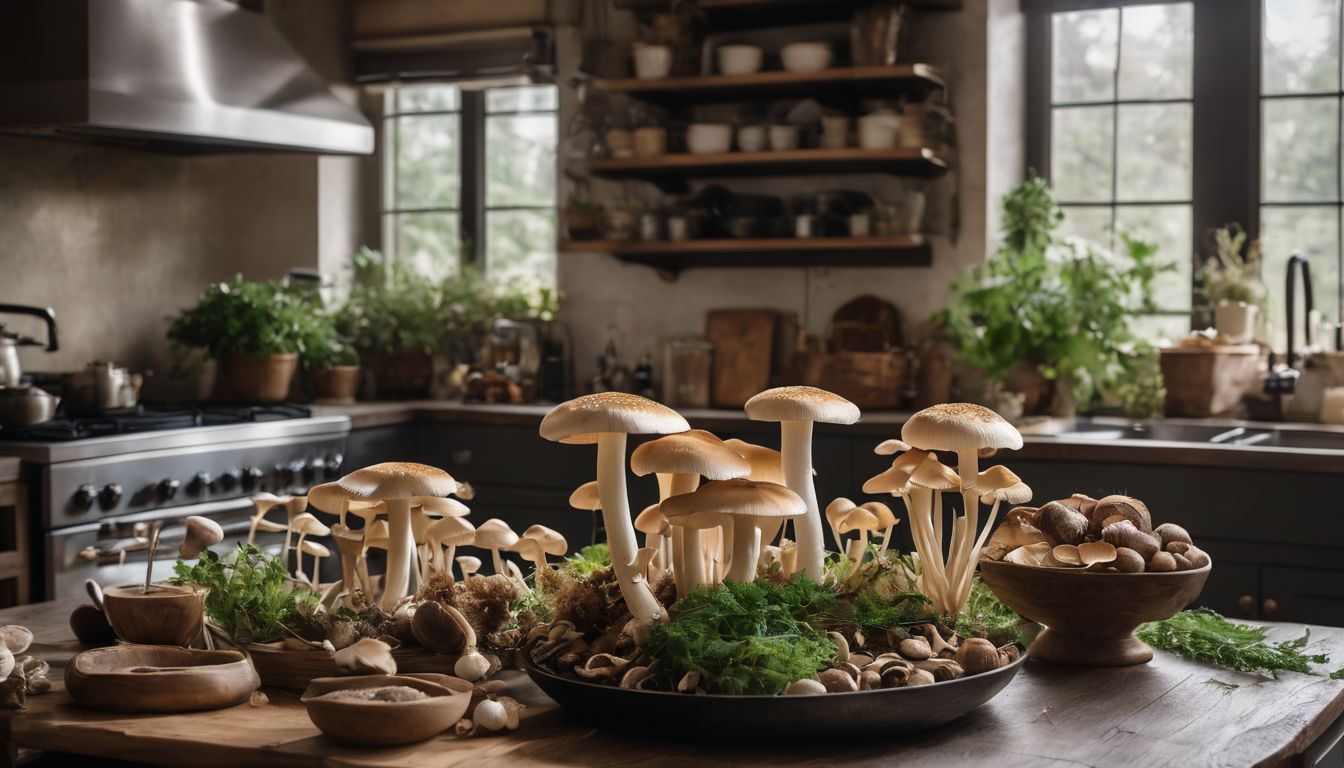Struggling to keep your green friends thriving indoors? Air plants, or Tillandsias, offer a unique twist in the plant world—they don’t need soil to grow! Our guide will arm you with simple tips and tricks to nurture these fascinating plants successfully.
Dive in for fresh air plant wisdom!
Key Takeaways
- Tillandsias, commonly known as air plants, thrive without soil by absorbing water and nutrients through their leaves, offering a diverse range for indoor gardening.
- Proper care includes regular misting or soaking while avoiding overwatering, ensuring bright indirect sunlight exposure and maintaining good air circulation to prevent rot.
- Air plants can be propagated using methods such as offsets and division to expand collections or share with others.
- Creativity in displaying air plants enhances decor; they can be presented in glass terrariums, on driftwood, or within various containers that facilitate airflow.
- Being vigilant about pests and providing the right environment will keep Tillandsias healthy; they survive best with temperatures between 50-90°F and humidity levels of 50-60%.
What are Air Plants (Tillandsias)?
Air plants, also known as Tillandsias, are a unique genus of plants that do not require soil for growth. They absorb water and nutrients through their leaves, making them perfect for low-maintenance indoor gardening.
There are over 600 different species of air plants, each with its own distinct appearance and care requirements.
Overview of Tillandsias
Tillandsias, often known as air plants, require no soil to thrive, making them a unique addition to any indoor environment. They absorb water and nutrients through their leaves from the air, unlike traditional potted plants.
This remarkable adaptation allows them to cling to nearly anything – rocks, trees or even on wires and shelves in your home. With over 650 different types of Tillandsias available, they offer an incredible variety of shapes, sizes and colours.
Caring for these resilient plants is straightforward with a few key maintenance tips. Regular misting keeps them healthy; however, occasional soaking can provide deeper hydration especially for those living in drier climates.
Bright indirect sunlight suits them best as direct light may scorch their delicate leaves. Ensuring good air circulation will mimic their natural habitats and help prevent any pest infestations or rotting issues that can occur if they remain wet for too long after watering.
Embracing Tillandsia care brings a touch of the wild into eco-friendly homes while asking very little in return from busy plant lovers.
Types of Air Plants
Air plants, also known as Tillandsias, come in various types, each with unique characteristics and appearances. Here are the different types of air plants:
- Tillandsia Ionantha: Known for its vibrant colouration and compact size, it is one of the most popular air plant species.
- Tillandsia Xerographica: Recognisable by its curly leaves and striking silvery-grey appearance, this type is sought after for its elegant beauty.
- Tillandsia Stricta: These air plants feature slender, bright green leaves and produce colourful blooms when they reach maturity.
- Tillandsia Bulbosa: With its unusual growth habit and twisting leaves, this type adds an intriguing touch to any display.
- Tillandsia Caput-Medusae: Named after its resemblance to the snake-haired gorgon from Greek mythology, this variety has distinctive curly arms.
- Tillandsia Brachycaulos: Characterised by its fiery red colouring during blooming, this type adds a pop of vibrant colour to any setting.
Caring for Air Plants
When it comes to caring for air plants, you’ll need to pay close attention to their watering needs and ensure they get the right amount of light and humidity. It’s important to also know how to fertilise them properly and be prepared to deal with any pests or problems that may arise.
Watering tips
To keep your air plants healthy, follow these watering tips:
- Water your air plants by soaking them in room temperature water for 20-30 minutes every 1-2 weeks.
- After soaking, gently shake the excess water off the plants and let them dry upside down to prevent water from pooling at their base.
- If your air plants are in a dry environment, mist them with rainwater or filtered water every few days.
- Ensure that the area around your air plants is well-ventilated to prevent moisture build-up, which can lead to rot.
- Use a spray bottle to lightly mist your air plants with water if they appear dehydrated between soakings.
Light requirements
Air plants require bright, indirect sunlight for at least 6-8 hours a day. To ensure optimal growth and health, place air plants near a window with sheer curtains or an area with filtered light. Avoid exposing them to direct sunlight for prolonged periods, as this can cause damage.
- Position air plants close to an east or west – facing window for gentle morning or afternoon sun.
- Consider using artificial grow lights if natural light is insufficient, ensuring they receive the required light intensity.
- Rotate the air plants regularly to allow all sides to receive equal sunlight exposure.
- Monitor the plant’s leaves – if they begin to curl or turn brown, adjust their positioning to a shadier spot.
- Ensure there are no obstructions blocking the light source from reaching the air plants.
Temperature and humidity
After considering the light requirements for air plants, it’s essential to also pay attention to temperature and humidity. Air plants thrive in a stable environment with temperatures ranging between 50-90°F.
They are resilient and can tolerate some temperature fluctuations, but extreme cold or heat should be avoided. Maintaining a relative humidity of 50-60% is ideal for air plants, ensuring they receive enough moisture without becoming waterlogged.
Proper temperature and humidity levels create an optimal growing condition for air plants, promoting healthy growth and vibrant blooms. By keeping these factors in mind, you can ensure your air plants not only survive but thrive in their environment.
Fertilising
To keep your air plants healthy and thriving, it’s essential to provide them with the necessary nutrients. Fertilising your Tillandsias is a crucial aspect of their care routine. Use a water-soluble fertiliser specially formulated for air plants, applying it once a month during the growing season.
Ensure that the fertiliser is diluted to half or even quarter strength to prevent any damage to the delicate roots of your air plants. By providing proper fertilisation, you can support robust growth and vibrant blooms in your Tillandsias, contributing to their overall health and longevity.
Maintaining proper nutrition through regular fertilisation helps air plants grow vigorously while encouraging flower production. Selecting a suitable water-soluble formula designed for epiphytic plants guarantees that the essential nutrients are available without overwhelming these unique plants’ delicate systems.
Dealing with pests and problems
Inspect your air plants regularly for pests such as aphids, mealybugs, or spider mites. Remove any visible pests with a gentle spray of water or by gently rubbing them off the plant.
To prevent pest infestations, ensure good air circulation around your plants and avoid overwatering. If you notice brown or black spots on the leaves, it may indicate fungal or bacterial infections.
Trim affected areas and adjust your watering routine to keep the plants dry to prevent further spread.
How to Propagate Air Plants
Learn the different methods for propagating air plants and discover tips for successful propagation. Whether you want to grow more of your favourite Tillandsias or share them with friends, our guide has got you covered.
Methods for propagating
To propagate air plants, you can use the following methods:
- Offsets: Remove offsets from the mother plant once they are a third of its size.
- Division: Gently separate clumps of air plants into smaller sections whilst ensuring each division has a healthy root system.
- Seeds: Collect and sow air plant seeds in a suitable growing medium to germinate.
- Tissue culture: Use tissue culturing techniques to grow new air plants from small tissue samples.
Tips for successful propagation
To successfully propagate air plants, follow these tips:
- Ensure the parent plant is healthy and mature before attempting propagation, as this will increase the chances of successful offspring.
- Choose the most appropriate method for propagation based on the type of air plant you have, such as division, offsets, or seed sowing.
- When separating offsets from the parent plant, make sure they have developed a good root system before planting them separately.
- Provide adequate humidity and warmth during the initial stages of propagation to encourage root and leaf growth.
- Use a well – draining substrate when potting propagated air plants to prevent waterlogging and root rot.
Displaying Air Plants
Get inspired with creative ways to display air plants in your home or office, from hanging them in glass terrariums to placing them on driftwood and other decorative containers. Explore the different types of containers that work best for showcasing these unique plants.
Creative ways to display air plants
Create a stunning visual display by hanging air plants in glass terrariums or on driftwood.
Types of containers to use
Once you’ve figured out how to creatively display your air plants, it’s time to consider the types of containers that best suit these fascinating plants. Here are some options for containers suitable for air plants:
- Glass terrariums: These transparent enclosures provide a modern and elegant way to showcase air plants, creating an eye-catching centrepiece for any room.
- Hanging planters: Utilise hanging planters made from materials like wood, metal, or ceramic to add a touch of greenery to your living space without taking up precious surface area.
- Seashells or driftwood: For a beachy and natural aesthetic, consider placing your air plants in seashells or on pieces of driftwood. The organic shapes and textures add a unique charm to the arrangement.
- Ceramic pots: Opt for small, colourful ceramic pots or bowls to create a simple yet striking display. These containers come in various shapes and sizes, allowing for versatile arrangements.
- Wire holders: Explore the use of wire holders or stands to suspend air plants in mid-air, adding an element of whimsy and creativity to the overall look.
- DIY moss balls: Construct your own kokedama-style moss balls by wrapping air plant roots with moistened sphagnum moss and suspending them with twine – a playful and eco-friendly way to exhibit your tillandsias.
- Macramé hangers: Elevate your indoor décor with macramé hangers that effortlessly complement the natural beauty of air plants while adding a bohemian touch to any space.
Frequently Asked Questions
Having trouble keeping your air plants alive? Get answers to common concerns and questions about air plant care. Learn expert tips for keeping your Tillandsias healthy and thriving.
Common concerns and questions about air plants
- Over – watering can be harmful to air plants, leading to rot. It’s important to ensure they dry completely after watering.
- Air plants require good air circulation, so avoid placing them in enclosed containers without ventilation.
- If your air plant’s leaves start curling or turning brown, it may need more water or humidity.
- Ensure that your air plants receive adequate light, but avoid direct sunlight as it can scorch the leaves.
- When fertilising your air plants, use a specialised fertiliser at quarter strength and do this no more than once a month.
- If pests such as mealybugs or spider mites appear, remove them by spraying the affected area with water or using a cotton swab dipped in rubbing alcohol.
- It is normal for older leaves of the air plant to turn brown and die off as new leaves grow from the center of the plant.
Tips for keeping air plants alive and healthy
To keep air plants healthy and thriving, follow these tips:
- Place your air plant in a location with bright, indirect light to ensure optimal growth conditions.
- Water your air plant by soaking it in room-temperature water for 20-30 minutes every 1-2 weeks, ensuring excess water is shaken off and the plant is allowed to dry completely within 4 hours.
- Maintain a consistent environment with temperatures above 10°C and relative humidity levels of 40-60%.
- Fertilise your air plant monthly with a water – soluble fertiliser diluted to half strength to provide essential nutrients for sustained growth.
- Check your air plants regularly for signs of pests or problems such as rot, and address any issues immediately using appropriate solutions.
Conclusion
In conclusion, caring for air plants requires regular watering, adequate light, and proper temperature and humidity. Propagating air plants can be achieved through various methods like division and offsets.
When displaying your air plants, get creative with different types of containers to add a touch of green to your living space. Regular maintenance and care will ensure healthy growth and thriving Tillandsias in your home.
FAQs
1. How do I water my Tillandsias properly?
Watering air plants is easy! Simply soak your Tillandsias in water and make sure to let them dry fully afterwards for their care requirements.
2. What kind of light do air plants need to grow?
Air plants need bright, indirect light to thrive, so place them where they’ll get plenty of light without direct sun rays hitting them.
3. Can you give me tips on maintaining my air plant?
Sure! For great air plant maintenance, mist your plants regularly and follow a consistent watering routine as outlined in an air plant care guide.
4. How often should I be caring for my Tillandsia plants?
Caring for Tillandsia involves soaking them once a week, ensuring good airflow for drying, and providing enough light—stick with this care routine!
5. Is there a special guide on how to grow Tillandsias indoors?
Yes! To successfully grow Tilandsias inside, just use a detailed growing and caring guide that focuses on the right growth conditions like proper watering tips and correct lighting.





